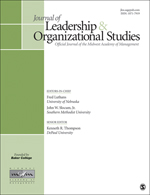Can Leaders Do More Than Just Motivate Employees to Be Creative?
Editor’s note: We are pleased to welcome Professor Sean R. McMahon of Elon University, whose paper “Heuristic Transfer in the Relationship Between Leadership and Employee Creativity,” co-authored by Cameron M. Ford of the University of Central Florida, was published in the Journal of Leadership & Organizational Studies February 2013 issue.
Can a leader actually make his or her employees more creative? Management research already highlights at least twelve styles of leadership – including transformational leadership, empowering leadership, and leader encouragement of creativity – that have each been found to positively impact employee creativity. Yet, each of these leadership styles is thought to enhance employee creativity through just one mechanism; boosting employee intrinsic motivation.
 An employee who is intrinsically motivated is an employee who is attracted to and energized by his or her work itself, rather than being motivated only by external results or rewards for completing that work. Indeed, research shows that a leader who makes employees energized about their work will have employees who are more likely to explore new ideas and conceive creative solutions. This sounds promising, right? It is, but it also conveys a secondary notion about the role of leadership and employee creativity. Namely, research implies that leaders cannot directly make an employee more creative and, as a result, are limited to creating an environment in which employee’s own creativity may reveal itself.
An employee who is intrinsically motivated is an employee who is attracted to and energized by his or her work itself, rather than being motivated only by external results or rewards for completing that work. Indeed, research shows that a leader who makes employees energized about their work will have employees who are more likely to explore new ideas and conceive creative solutions. This sounds promising, right? It is, but it also conveys a secondary notion about the role of leadership and employee creativity. Namely, research implies that leaders cannot directly make an employee more creative and, as a result, are limited to creating an environment in which employee’s own creativity may reveal itself.
 My paper with Cameron Ford takes a modest first step in exploring whether leaders can, in fact, directly enhance their employees’ ability to be creative. We developed a construct called Leader Heuristic Transfer (LHT), which looks at the extent to which supervisors articulate their own heuristics or problem solving “rules of thumb” to their employees. LHT is founded on the recognition that creativity involves non-specific skills like pattern recognition that can be used across different settings, that such skills can be sharpened when individuals interact with each other, and that leaders are in a unique position to use their interaction with employees to enhance the ways in which those employees evaluate and approach challenges and opportunities.
My paper with Cameron Ford takes a modest first step in exploring whether leaders can, in fact, directly enhance their employees’ ability to be creative. We developed a construct called Leader Heuristic Transfer (LHT), which looks at the extent to which supervisors articulate their own heuristics or problem solving “rules of thumb” to their employees. LHT is founded on the recognition that creativity involves non-specific skills like pattern recognition that can be used across different settings, that such skills can be sharpened when individuals interact with each other, and that leaders are in a unique position to use their interaction with employees to enhance the ways in which those employees evaluate and approach challenges and opportunities.
The results of our study support our hypothesis that increased LHT enhances employee creativity. Further, our data suggest that the relationship between LHT and employee creativity persists even when controlling for individual personality traits related to creativity, job requirements necessitating creativity, and leadership attributes promoting intrinsic motivation. More work needs to be done, but our results imply a more comprehensive role for supervisors. Where current leadership styles prime employee intrinsic motivation in the hope of creativity as a by-product, the transfer of heuristic tools such as LHT may boost creative ability directly, with motivation as the by-product of a more apt employee.
Read the paper, “Heuristic Transfer in the Relationship Between Leadership and Employee Creativity,” in the Journal of Leadership & Organizational Studies.
 Sean R. McMahon, PhD, is Assistant Professor of Entrepreneurship in the Love School of Business at Elon University. His research presently focuses on innovation and knowledge transfer. Prior to doctoral studies, he co-founded, managed, and sold his own entrepreneurial venture, Jaywalk, Inc., to a Fortune 500 company, The Bank of New York.
Sean R. McMahon, PhD, is Assistant Professor of Entrepreneurship in the Love School of Business at Elon University. His research presently focuses on innovation and knowledge transfer. Prior to doctoral studies, he co-founded, managed, and sold his own entrepreneurial venture, Jaywalk, Inc., to a Fortune 500 company, The Bank of New York.































































































